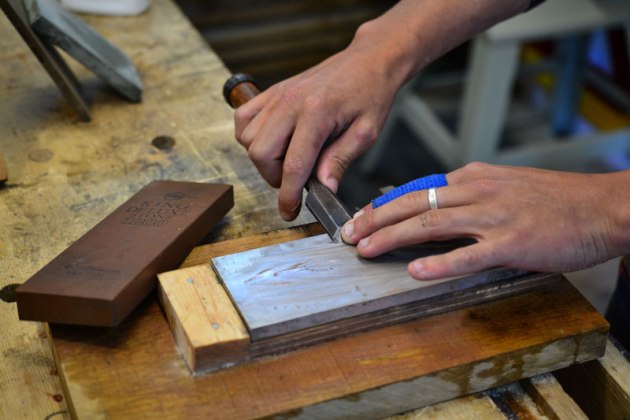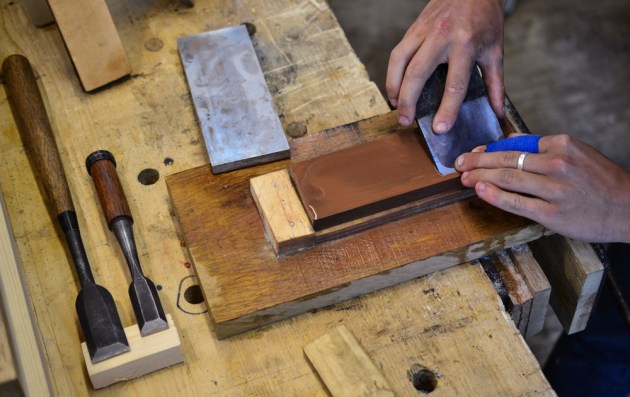When to sharpen
Above: Takami Kawai, Japanese carpenter and teacher
Words and photos: Harry T. Morris
Sharpening is of course a huge part of woodworking, much bigger than it initially seems. The more invested you become in woodworking, the more you are engulfed by the complexity of what is theoretically a simple concept.
Repeat performance
Learning to sharpen is futile without understanding what it means to be sharp. This was my main issue when I first watched someone sharpen a plane iron and then tried to sharpen my own. I was just repeating the motions I saw without fully appreciating what I was working towards.
The idea of ‘if I perform this action, I will get this result’, in hindsight, is almost primitive. It is like training a dog or a dolphin with a clicker; if they do well they get a click and quickly associate the click with that action and a reward, and thereafter repeat the action without understanding of why that action is good, only that it is.
1. Flattening the back of a chisel on a steel lapping plate.
You can stand at a sharpening stone for hours and hours doing what appears to be sharpening but without a fundamental understanding of what you are working towards and what it physically means to have a sharp edge. The edge may never become sharp; and if it does, you’ve got lucky.
What is sharp?
Sharpness is a very simply concept that took me a good while (and a very good teacher) to get my head around. All you need is two planes (not woodworking planes, a two dimensional surface), with as few surface imperfections as possible, meeting at an edge. And that is perfectly sharp.
In reality, having this idea in mind helps to no end in getting closer to achieving it. I am not just making two faces shiny, or just abrading metal as a specific angle, I am creating two, smooth and intersecting planes in the shape that is most useful for the tool’s function (usually flat).
2. Working the bevel of the blade on a 1000 grit waterstone.
Understanding the fundamentals of every process is crucial to progress in learning and refining skills – as mentioned it is easy to become stuck repeating actions you believe to be the right ones. This may yield satisfactory results, but without truly understanding why you are doing what you are doing, there will always be a barrier to your progression.
Sharpening is not a barrier to entry of woodworking, firstly because people work with blunt tools, and good work can be done with sub par tools, but there is a point that will be reached that without the next level of understanding is impossible to progress past.

3. A light spray of water is enough to lubricate the stones.
This was illustrated in a graph of skill level plotted against time that Tak Yoshino, a Japanese chairmaker, once described to me. He described how the relationship is not linear, there are times where your skill level jumps when you learn something new or have a revelation. Often before these times comes a period where your skill level plateaus, and leads you into a rut which clouds your ability to see your final skill level goal, but your goal will become visible again once a barrier is conquered. Understanding sharp is one of these ruts that need jumping over.
How often?
So I understand what sharp is and what I am aiming for when sharpening, but when should I be sharpening? This question is both easy and difficult to answer.
The short answer is now, as often as you can. But that’s not too helpful, in reality maintaining tools well requires discipline.
What I have found works best is sharpening and caring for my tools as often as I can, in short sessions. Before studying woodworking in Japan I would use my tools until they did not function as they should and until I couldn’t work efficiently any more. I would then sharpen them in bulk, which seemed to make sense to me.

4. The bevel is next flattened on a 3000 grit stone.
After learning the true importance of a sharp tool to progress past that barrier, my process has now changed. Efficiency is of course an ongoing goal (especially a commercial workshop), and for me it was a false economy to try and work for as long as possible before sharpening, because the quality and enjoyment of the work suffered (even only slightly). I now find myself sharpening before I start a process, or even better, after every process the question is, is how small a process? After one component? One joint? I find that process to be fairly small, not quite as small as resharpening after one joint, but more like after one step in the project. If time is taken to sharpen precisely to begin with, then resharpening can be only a few passes on a fine stone.

5. Moving to 6000 grit the back and bevel are again flattened.
Sharpening at the end of a day is great, I am ready to go first thing; but for me it is often difficult to find the energy at the end of a day. I sharpen at least one of my chisels or planes every day when mid-project. Often a few chisels at a time. This is only a couple of minutes on the stone, the main work – making the shape of the blade – has been done.
My process
My sharpening process has become quite simple. As is my collection of tools. For a new chisel or one I have not sharpened before I first work on the back of the blade; without this surface flat the chisel does not function as it should. Once you can rely on the back of a chisel being flat it changes the potential level of precision of your work, everything becomes more predictable.

6. The back of this Japanese kanna blade is first carefully flattened.
Flatten the back
I flatten the back of my blades on a steel lapping plate with 1000 grit abrasive powder and water on the surface (often just dried slurry from my 1000 grit stone).
Once the back is flat, and I have a consistent burr on the bevel side, I progress to my next stone, 1000 grit. I use Japanese waterstones because I like how quickly they cut, and find them much more satisfying to use than oilstones. On my 1000 grit stone I only work the bevel of the blade. Here I am achieving the same goal as the back; flat, and roll a consistent burr over to the back.
7. Day to day sharpening is on 5000 and 8000 grit stones – the 8000 is shown here.
Flatten the face
For me, having this face flat is important, it makes the cut more predictable, and resharpening much easier. The same (theoretically) can be achieved with a hollow grind, but that’s not how I have ever done it. I sharpen freehand, moving the blade in short strokes, parallel to the edge, all over the stone. Once I have been over all areas of the stone I flatten the stone using a diamond plate, and repeat until the edge is consistent.
Honing
I have now made the shape of the blade and the remaining job is to hone, a faster task. I progress through 3000, 6000 and 8000 stones, using the same process – and on the finest stone also hone the back, being very careful at this point to keep the blade flat on the stone, and the stone flat. A dry stone can be used for an even finer polish.

8. The back of the sharpened kanna plane blade shows the hollow grind.
Day to day sharpening usually only consists of returning to the 5000 and 8000 stones, once in a while re-making the shape of the blade on the more coarse stone. The beauty of having flat surfaces right to the edge with no micro bevel is the ease of maintenance. With a micro bevel I can never hit the same angle and end up increasing it until it is very steep and not very useful at all.
Honing guides are fantastic if they stay locked down, and are a great way to achieve reliable results. However I feel the muscle memory of freehand sharpening is an invaluable skill to obtain.
Objects as a by-product
I believe that the best way to learn fine woodworking is to consider the objects I make as a by-product of practising with the tools. If I have in my head that I am sharpening this plane iron to joint the edges of a tabletop, then I tend to rush through it or not do as good a job because my mind is not entirely focused – I need to be concerning myself with the edge of the iron and the stone, nothing more. Equally with almost every action, if I am making a saw cut I need not been thinking about what component I am cutting to length, rather that my cut is true and square, and my saw is kept sharp and clean.

9. The front of a sharpened kanna plane blade.
If you find a way to gain this focus and mindset in your work, tell me how... It is of course a romanticised view on what are everyday things for a lot of us, and much easier said than done – but these are crucial steps to jumping those barriers to progression and realising why and how we got the good dolphin click.

10. These stones and lapping plates comprise the author’s sharpening set-up.
Harry Morris is a UK furniture maker who favours the use of traditional hand tools and methods. In issue 106 he wrote about the making of a cabinet from recycled timber. Learn more at www.HTMorris.com and Instagram @HTMorrisFurniture






